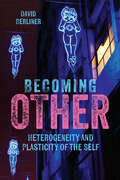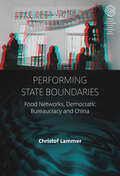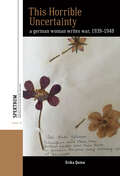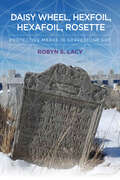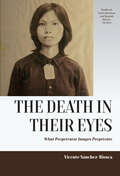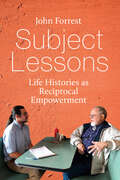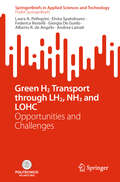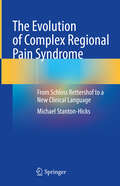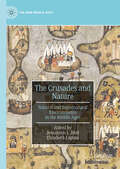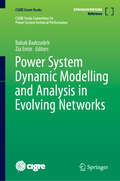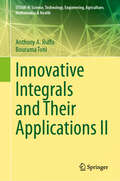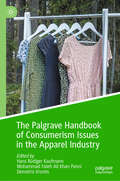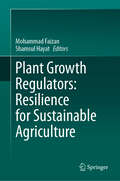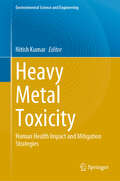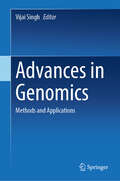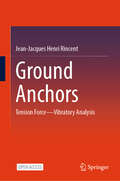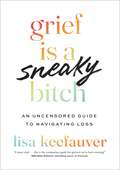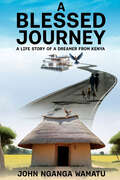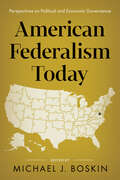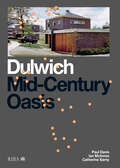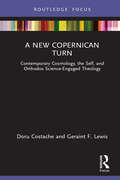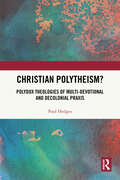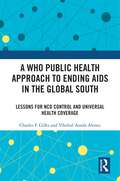- Table View
- List View
Unexpected Encounters: Migrants and Tourists in the Mediterranean (Articulating Journeys: Festivals, Memorials, and Homecomings #4)
by Francesco ViettiExploring the intersections between migration and tourism in the Mediterranean, this book is the result of extensive ethnographic research carried out over a decade in the Mediterranean regions. It focuses on three interrelated themes: the experiences of homecoming migrants who visit their country of origin for holidays; the inequalities surrounding the encounters between local people, tourists and migrants in borderlands; and how migration and tourism affect cultural heritage in European cities. The book shows how interconnected mobilities play a crucial role in boosting the global dynamics of cultural, social, economic and political transformation in the Mediterranean.
Becoming Other: Heterogeneity and Plasticity of the Self
by David BerlinerMost of us are conscious of having a single and stable self, but the self is more fragmented and plastic than we care to think. David Berliner explores the captivating world of identity through an array of astonishing experiences. From Napoleon doppelgangers to Philip Roth's alter-ego Nathan Zukerman and Wonder Woman cosplayers to anthropologists going native, he delves into the kaleidoscopic nature of the self and attempts to understand the heterogenous nature of identity. But Becoming Other also discusses a great cultural controversy of our time: who has the right to play at being whom?
Performing State Boundaries: Food Networks, Democratic Bureaucracy and China (EASA Series #51)
by Christof LammerPolarizing images of authoritarian, socialist or culturalist otherness compromise analyses of the Chinese state. Still, such images produce effects beyond academia when they inform performances of the boundaries between state and non-state. This book shows how performative boundary work leads to contrasting judgements that decide about support and access to resources. In an ecological village in Sichuan, citizen participation in food networks and bureaucracy signaled Western liberalism, Maoism or traditional rural culture for different audiences. Attention to the multiplicity of performed state boundaries helps China studies and political anthropology to understand such diverging classifications – and how they sometimes co-exist without causing tensions.
This Horrible Uncertainty: A German Woman Writes War, 1939-1948 (Spektrum: Publications of the German Studies Association #32)
by Erika QuinnThrough the diaries and personal papers of a German woman, Vera Conrad, this book documents her wartime experiences and deepens our understanding of the complex experiences of trauma and grief that National Socialist supporters experienced. Building on scholarship about mourning and widowhood that largely focuses on state policies and public discourses, This Horrible Uncertainty provides an interpretive framework of people’s perceptions of events and their capacity to respond to them. Using a history of emotions approach, Erika Quinn establishes that keeping the diary allowed Conrad to develop different selves in response to her responsibilities, fear, and grief after her husband was declared missing in 1943.
Daisy Wheel, Hexfoil, Hexafoil, Rosette: Protective Marks in Gravestone Art
by Robyn S. LacyThe use of protective symbols, also known as apotropaic marks, are often part of folk magic traditions, appearing in homes, churches, on personal items, and even graves, across Europe, Australia, and North America. The most common and well-known of these marks is the hexfoil, otherwise known as the daisy wheel, witch hex, or rosette. Hexfoils have a history of use for personal protection and were carved both intentionally or graffitied into church pews and walls, bed frames, doors, and gravestones. This research sheds light on the use of this historic symbol to protect the bodies and souls of the deceased, across several thousand years and multiple countries.
The Death in their Eyes: What Perpetrator Images Perpetrate (Studies in Latin American and Spanish History #12)
by Vicente Sánchez-BioscaImages that embody the point of view of the perpetrators of violent crimes, or their accomplices, force us to look at the pain of victims through the eyes of those who caused it. Accompanied by over sixty visuals of historically infamous violence, The Death in their Eyes goes beyond the visible aspects of images to reveal what has been left outside of the frame. Covering human abuse and humiliation at Abu Ghraib, the Auschwitz Album, religious desecration during the Spanish Civil War, an unfinished Nazi propaganda film made at the Warsaw Ghetto in the spring of 1942, and detainees at the S-21 torture center in Cambodia under the Khmer Rouge, this volume proposes a rigorous new methodology for analyzing perpetrator images, in photography and film, that continue to be used and re-appropriated in today’s media. Content warning: This book contains images of victims of murder and torture which are essential to the author’s analysis.
Subject Lessons: Life Histories as Reciprocal Empowerment
by John ForrestLife histories are a class of oral data distinct from memoirs, autobiography, and conventional history in multiple ways. It is a way to lay out the felt experience of events in people’s everyday lives and not simply the statement of historical facts. As narrated pieces, life histories possess the unique voice of the individuals. Collecting data through life histories enables the interviewer-interviewee to develop a special bond that has the capacity to empower both in different ways. Subject Lessons examines the use of and value in using one’s life history as research within the social sciences.
Green H2 Transport through LH2, NH3 and LOHC: Opportunities and Challenges (SpringerBriefs in Applied Sciences and Technology)
by Laura A. Pellegrini Elvira Spatolisano Federica Restelli Giorgia De Guido Alberto R. de Angelis Andrea LainatiThis book explores the opportunities and challenges of hydrogen transport through different carriers (i.e., liquefied hydrogen, ammonia, toluene, and dibenzyltoluene). Each value chain analyzed includes: renewable H2 conversion to the carrier, storage of the hydrogenated carrier, its seaborne transport, reconversion of the carrier to produce H2 and hydrogen distribution. The conversion and reconversion processes are the cost drivers of the whole value chain. These stages are investigated through an in-depth techno-economic assessment, to highlight the critical issues and the need for further investigation (low TRL). The alternatives are examined considering: different H2 applications (industrial and mobility sector); different costs of utilities (present and future scenarios); and different distances from the loading to the unloading terminal. All these scenarios are discussed and compared by means of the levelized cost method, to understand which is the most cost-effective choice for each case study. As a result, H2 application to the industrial sector shows the lowest costs, with ammonia being the best alternative for transporting and storing hydrogen in this case. Liquefied hydrogen is the most expensive H2 carrier for the industrial application, as a consequence of the high liquefaction costs while holding promises for the mobility sector.
The Evolution of Complex Regional Pain Syndrome: From Schloss Rettershof to a New Clinical Language
by Michael Stanton-HicksLong before any written accounts of what has come to be described as Complex Regional Pain Syndrome (CRPS), this book entails a record that began in the department of Anesthesiology headed by Dr. John Bonica who during the Pacific arena of World War II came to manage thousands of wounded servicemen many of whom suffered from this complicated clinical entity often long after their original wounds had healed. Divided into two sections, the first provides a detailed chronology of the research and establishment of diagnostic criteria for CRPS. The second section provides an overview of how CRPS is evaluated and treated, along with the research that serves as its foundations.
The Crusades and Nature: Natural and Supernatural Environments in the Middle Ages (The New Middle Ages)
by Elizabeth Lapina Jessalynn L. BirdThe Crusades and Nature: Natural and Supernatural Environments in the Middle Ages explores the intersection of crusader studies and studies of nature. The volume addresses encounters with, responses to and representations of a broad variety of phenomena: celestial objects and events; familiar and unfamiliar fauna and flora; seascapes and landscapes; the elements and the seasons; etc. It introduces readers to crusaders’ actual, but also largely or entirely imaginary encounters with natural phenomena, as well as literary references to nature in crusader sources more generally (such as, for example, animal metaphors). Finally, this project investigates the relationships between the natural and the supernatural and between nature and human-made environments. The volume will define “crusades” broadly, to include not only crusades to the East, but also crusades to frontier regions such as the Baltic and Iberian peninsula and extends to representations of crusades and nature in later medieval and early modern sources.
Power System Dynamic Modelling and Analysis in Evolving Networks (CIGRE Green Books)
by Babak Badrzadeh Zia EminThis Green Book is an essential resource for power system engineers seeking comprehensive information on contemporary power system dynamic modelling and analysis. With today's rapid adoption of inverter-based resources and the resulting changes in power system dynamics, this book compares conventional power systems with evolving power systems characterized by high shares of grid-connected and distributed inverter-based resources. It covers dynamic phenomena, analysis methods, simulation tools and enablers required for secure and reliable system planning and operation. Starting with an overview of power system studies and associated analysis tools, the book provides modelling requirements for various power system components, including existing and emerging technologies. It includes practical examples from real-world power systems worldwide that act as step-by-step study guides for practising engineers and provides knowledge to apply in their day-to-day tasks. Additionally, the book emphasizes the importance of power system model acceptance testing and validation, providing practical examples of various testing methods. Written with practising power system engineers in mind, this book minimizes the use of advanced mathematics. However, relevant sources for those interested in learning more about mathematical concepts are provided. Overall, this book is an invaluable resource for power system engineers navigating contemporary power systems. Readers who would like to comment on any of the published books or identify errors to the editorial team please contact: cigregreenbooks@springer.com.
Innovative Integrals and Their Applications II (STEAM-H: Science, Technology, Engineering, Agriculture, Mathematics & Health)
by Bourama Toni Anthony A. RuffaIn its second installment, Innovative Integrals and Their Applications II explores multidimensional integral identities, unveiling powerful techniques for attacking otherwise intractable integrals, thus demanding ingenuity and novel approaches. This volume focuses on novel approaches for evaluating definite integrals, with the aid of tools such as Mathematica as a means of obtaining useful results. Building upon the previous methodologies, this volume introduces additional concepts such as interchanging the order of integration, permutation symmetry, and the use of pairs of Laplace transforms and Fourier transforms, offering readers a comprehensive array of integral identities. The content further elucidates the techniques of permutation symmetry and extends the multivariate substitution approach to integrals with finite limits of integration. These insights culminate in a collection of integral identities involving gamma functions, incomplete beta functions, Bessel functions, polylogarithms, and the Meijer G-function. Additionally, readers will encounter applications of error functions, inverse error functions, hypergeometric functions, the Lambert W-function, elliptic integrals, Jacobi elliptic functions, and the Riemann zeta function, among many others, with a focus on their relevance in various scientific disciplines and cutting-edge technologies. Each chapter in this volume concludes with many interesting exercises for the reader to practice. A key tenet is that such approaches work best when applied to integrals having certain characteristics as a starting point. Most integrals, if used as a starting point, lead to no result at all, or lead to a known result. However, there is a special class of integrals (i.e., innovative integrals), which, if used as a starting point for such approaches, lead to new and useful results, and can also enable the reader to generate other new results that do not appear in the book. The intended readership includes science, technology, engineering, and mathematics (STEM) undergraduates and graduates, as well as STEM researchers and the community of engineers, scientists, and physicists; most of these potential readers have experienced the importance and/or the applications of integration from finding areas, volumes, lengths, and velocities to more advanced applications. The pedagogical approach of the exposition empowers students to comprehend and efficiently wield multidimensional integrals from their foundations, fostering a deeper understanding of advanced mathematical concepts.
The Palgrave Handbook of Consumerism Issues in the Apparel Industry
by Demetris Vrontis Hans Rüdiger Kaufmann Mohammad Fateh Ali Khan PanniThis handbook offers a comprehensive overview of consumerism issues in the textile, apparel and fashion industry, illustrating the impact of consumerism on the sector with a focus on SDG 12: Responsible Consumption and Production. The book presents a synthesis of mainstream and emerging thinking and studies on green, ethical, social and environmental issues. Currently, marketing practices place emphasis on sustainability and social responsibility. Although corporate strategies embrace this notion by claiming to be socially responsible and environmentally friendly, the truth is still debatable. In light of this, scholars and practitioners need to effectively and convincingly respond to consumer concerns on sustainability by adapting their business practices. Split into seven parts, the Handbook covers theoretical challenges on sustainable consumerism in the apparel industry, the influence of sustainable consumerism, conceptual frameworks and cross-cultural consumer behaviour, macro and micro issues, innovative trends, and communication. With discussion of pressing issues such as modern slavery, greenwashing, social media, luxury consumption and sustainable development, the book also illustrates the practical implications from a marketing and production point of view in this sector.
Plant Growth Regulators: Resilience for Sustainable Agriculture
by Shamsul Hayat Mohammad FaizanThis edited book focuses on plant growth regulator synthesis, potential applications, stress tolerance mechanisms and preservations. It explores the recently registered molecules strigolactones, karrikins, and hemin-mediated regulation of plant biology. Chapters cover the integration of plant hormones in the biological system as an opportunity for sustainable agriculture. This book explores the latest information on plant growth regulators covering both theoretical and practical aspects. Plant growth regulators are organic chemical compounds that alter or regulate the metabolism in plants. In plants, plant growth regulators play the role of biostimulants that can enhance resistance to stress. Plant growth regulators in low concentrations often lead to vital improvements and high yields in crop plants. Plant growth regulators are involved in several physiological, morphological, and biochemical mechanisms associated with plant growth, development and defence againststresses. This book brings together the latest research work on plant growth regulators and their emerging importance. The book is a useful read for students, researchers, and instructors in the field of plant biology.
Heavy Metal Toxicity: Human Health Impact and Mitigation Strategies (Environmental Science and Engineering)
by Nitish KumarThis edited book brings together a diverse group of environmental science, sustainability, and health researchers to address the challenges posed by global mass poisoning caused by heavy metals contamination of soil and plants. In recent years, contamination of the environment by heavy metals has become a major concern. Their multiple industrial, domestic, agricultural, medical, and technological applications have led to their wide distribution in the environment, raising concerns over their potential effects on human health and the environment. Owing to their toxic, non-degradable, and bio-accumulative nature, the health burden on the population has increased significantly. Heavy metals such as arsenic, lead, mercury, cadmium, and uranium do not play a significant role in metabolism in the human body and are thus toxic. Their exposure in high concentration can cause acute toxicity resulting in acute health conditions, which is easy to observe and regulate, while similar is not visible for immediate action when their exposure is in trace amounts over the years. Heavy metals enter in the food chain through consumption of plant material. A high concentration of heavy metals has been found to be harmful to vegetation. As the heavy metals concentration in plants increases, it adversely affects several biological parameters and eventually renders the soil barren.The book sheds light on this global environmental issue and proposes solutions to contamination through multi-disciplinary approaches and case studies from different parts of the world. This book is a valuable resource to students, academicians, researchers, and environmental professionals who are doing field work on heavy metals contamination throughout the world.
Advances in Genomics: Methods and Applications
by Vijai SinghThis book provides a comprehensive overview of genomics and its diverse applications. Chapters cover genomics data generation methods, computational tools, gene annotation, transcriptomics, DNA barcoding, next-generation sequencing, functional genomics, metagenomics, synthetic genomics, microarray analysis, nutrigenomics, genome editing, and more. This book offers a valuable source of information for not only beginners in genomics, but also for students, researchers, scientists, clinicians, practitioners, policymakers, and stakeholders who are interested in harnessing the potential of genomics in many areas.
Ground Anchors: Tension Force—Vibratory Analysis
by Jean-Jacques Henri RincentThis open access book introduces a non-destructive vibration analysis method for calculating the internal tension force of tested tie rods. This method was formalized in 2003 and patented after two years of investigation, with the patent expiring in 2005. The objective of the book is to present this method through numerous concrete examples. It covers the theory and principles of instrumentation, explaining how vibratory responses are analyzed to calculate the free and total lengths of the tie rod, as well as its diameter, which includes the reinforcement and its grout. The data obtained from this method can be utilized to: Verify that tie rods adhere to drawings Resize tie rods A notable strength of this book lies in demonstrating the relationship between dynamic stiffness and the tension force of the tie rod, along with the calibration method using static tensile tests. However, performing static tensile tests at heights poses difficulties due to equipment weight, and there is a genuine risk of failure, especially for older tie rods. The book addresses important aspects such as the uncertainty of results and sampling. The examples provided in the book primarily stem from tests conducted in Brazil, where more than 2,000 tie rods were tested over a two-year period on motorway and railway retaining walls. In practical terms, this amounts to 16,000 non-destructive tests as each tie rod is tested eight times. These aging structures, in existence for several decades, exhibit load losses ranging from 1% to 5.5% per year during these periods. The book acknowledges the observation of cyclic load effects on these reinforcements, which warrant further investigation. In one of the tested walls, a limited number of tie rods were re-tensioned. Retaining wall managers increasingly employ this method for maintenance diagnostics. It allows for a representative sample to be taken, providing insight into the existing conditions.
Grief is a Sneaky Bitch: An Uncensored Guide to Navigating Loss
by Lisa Keefauver'A truly helpful, honest, and important trail map for the journey we all eventually must take through grief' - Steve Leder, New York Times bestselling author of The Beauty of What Remains'An immense amount of knowledge and science around grief and the grieving process' - Colin Campbell, author of Finding the WordsWhen social worker Lisa Keefauver became a widow in 2011, she was alarmed to discover that even though 100 percent of us experience loss, we're living in a grief illiterate world. In her work as a therapist, and in her search for help in the wake of her own loss, Keefauver began to see how the misguided stories we consume about grief lead to unnecessary suffering. Responding to the problematic narratives that grief is something to move on from after completing the five stages like some sort of to-do list, Keefauver became a grief activist. Through this book and her hit podcast of the same title, she creates a safe place to be inside the messiness of it all, to discover the full spectrum of grief, and to find the tools that help grievers move forward, not on. Grief is a Sneaky Bitch is a comprehensive guide-both a manual full of insights and skills and, even more importantly, a thoughtful companion that helps readers feel seen and held. Keefauver shares her personal and professional wisdom alongside the lessons she's learned from clinicians, authors, poets, and friends. In place of rigid instructions and must-do checklists, Grief is a Sneaky Bitch invites reflection, encourages self-compassion and explores the therapeutic power of humour with, yes, a bit of profanity.
A Blessed Journey: A Life Story of a Dreamer from Kenya
by John Nganga WamatuWhen John was young, he discovered himself and realized he was on the road and a journey. The journey seemed full of excitement, naivety, and hope. As he grew older, he went through a brutal period of hard work to achieve the goals he set for himself. Toward the end, John reaches a point of reflection and slows down to allow the next generation to continue the journey and tell new stories. In telling the story about his life, he attempts to mention some events he observed along the way. In this memoir, John shows that he came from a humble background and went through multiple blessed moments to reach a place where he can look back and call his life a blessed journey. When reading A Blessed Journey, you are invited to read and appreciate the author's life story by sharing the experiences that brought him varied emotions.
American Federalism Today: Perspectives on Political and Economic Governance
by Michael J. BoskinWhat are federalism's challenges and opportunities today? The framers of the US Constitution enumerated specific powers for the federal government, leaving all else under the purview of states or the people. Over time, the federal government has expanded its role, yet the American people have more trust in state and local governments that are closer to them—and where co-partisanship is often a matter of necessity. Scholars and practitioners in policymaking gathered at the Hoover Institution in September 2023 to discuss the ramifications of federalism for contemporary issues. American Federalism Today presents those conference proceedings. Renowned experts from a range of disciplines, including economics, political science, history, and law, lay out the key priorities in evaluating and reinvigorating America's federal system of governance. Among the topics they examine are infrastructure, education and healthcare financing, trust in government, and intergovernmental relations in an era of rising federal debt and unfunded state and local liabilities. Three influential governors—Mitch Daniels, Jeb Bush, and Jerry Brown—describe navigating the federalist system as they led their states through many challenges. This unique compilation draws on the remarkable expertise and experience of its contributors to probe federalism's strengths, weaknesses, opportunities, and challenges in the nation's political and economic governance.
The Gods Give My Donkey Wings (Hesperus Classics)
by James BarrFollow the reflective narrative of a packman, reminiscent of contemporary religious/political allegory, as he ventures with his faithful donkey to a mountaintop utopian town.
Dulwich: Mid-Century Oasis
by Paul Davis Elisabeth Kendall Ian McInnes Catherine SamyDulwich’s mid-century modern architecture is increasingly recognised for its qualities of light, landscape and lifestyle. In the 1950s, 60s and 70s, around 2,000 new homes were created to the most modern standards without destroying the qualities which had made Dulwich so attractive to previous generations. With both historic and new photography, this book showcases the award-winning work of the Dulwich Estate’s architects, Austin Vernon & Partners, working with house builder Wates. Today, there is much to be learned from the architects and landscape planners who saw their role as fundamental to building Britain’s modern society.
A New Copernican Turn: Contemporary Cosmology, the Self, and Orthodox Science-Engaged Theology (Routledge Focus on Religion)
by Doru Costache Geraint F. LewisThis short book discusses the latest in terms of cosmology’s knowns and unknowns and sets out to ascertain the potential of Orthodox Christian theology for accommodating the current scientific view of the universe. It also addresses one of cosmology’s unknowns, the destiny of the self in the vastness of space, a topic that has caused angst since the dawn of modern science.The book examines, accordingly, the signs of a “New Copernican Turn” within contemporary culture, favouring the self and its meaningful encounters with the infinite universe, at the forefront of which being the quest for a physics that views something akin to the self as undergirding reality, not as an inconsequential byproduct of natural phenomena. The book further shows that theological, spiritual, and religious forms of nature contemplation and wonder facilitate the self’s creative intersection with the universe. It amounts to an exercise in science-engaged Orthodox theology that takes contemporary cosmology as a starting point.The intended audience of this book is scholars and researchers of science and religion, religious studies, philosophers, and theologians.
Christian Polytheism?: Polydox Theologies of Multi-devotional and Decolonial Praxis
by Paul HedgesThis book is a theological and political exploration of how Christianity may be compatible with polytheism, arguing that there is no singular "orthodoxy", rather we see "polydoxy".Conceptually deconstructing the distinction between monotheism and polytheism, it advances multi-devotionalism and mono-devotionalism as analytically preferable terminology. It starts by exploring notions of polytheism in the Old(er) Testament, New(er) Testament, and Christian developments of the Trinity over subsequent centuries, before placing Christianity in comparative dialogue with Islam, Judaism, and Hinduism. Employing a decolonial and feminist stance, the book proceeds to examine global Christianities, focusing on African and Asian theologies as well as Goddess traditions. It concludes by offering five options for developing a theology of Christian polytheism: Henotheist originalism, theologies of plurality, generous orthodoxy, atheistic Christian polytheism, and a theology of polytheistic excess.This original and compelling volume is essential reading for scholars of Christian Systematic Theology and Modern Theology.
A WHO Public Health Approach to Ending AIDS in the Global South: Lessons for NCD Control and Universal Health Coverage
by Charles F. Gilks Yibeltal Assefa AlemuIn highlighting how a WHO Public Health Approach (PHA) has been successfully used in developing countries to provide HIV/AIDS patients with antiretroviral therapy (ART), this important book provides a template for how the PHA can be implemented to treat other chronic but non-communicable diseases (NCDs) as well. With over 28 million people globally now receiving treatment for HIV/AIDS, it’s clear there are lessons to be learnt from the provision of ART which have great relevance for NCD care and towards achieving universal health coverage in the global south.The first section of the book provides a detailed overview of the strategy that enabled such a successful programme to be taken place, the challenges faced and its evolution over time. The book then moves on to assert that by approaching other chronic NCDs in a similar way, focussing on populations with integrated long-term and short-term person-centred care, there is a pathway towards universal health care and Universal Health Coverage across the developing world.Discussing many of the most pressing diseases and public health issues affecting these regions, this book provides global health scholars and practitioners with a detailed analysis of the challenges faced in tackling these diseases, but also an integrated person-centred health-care approach by which these challenges may be met.

